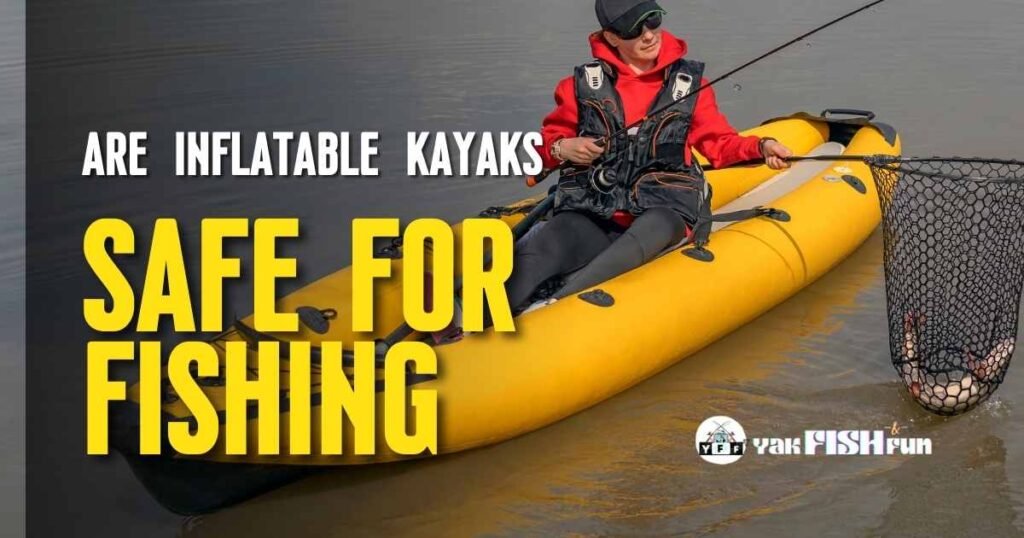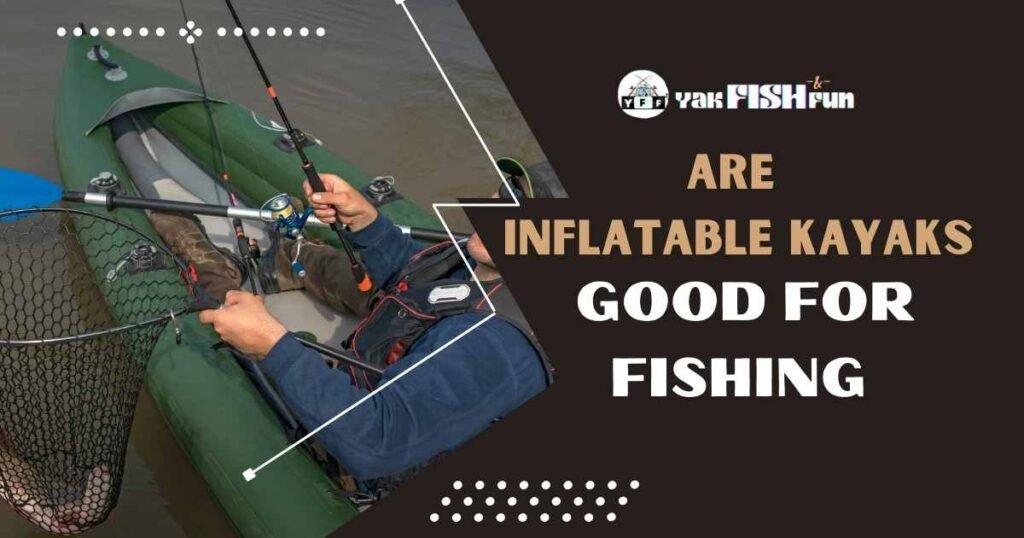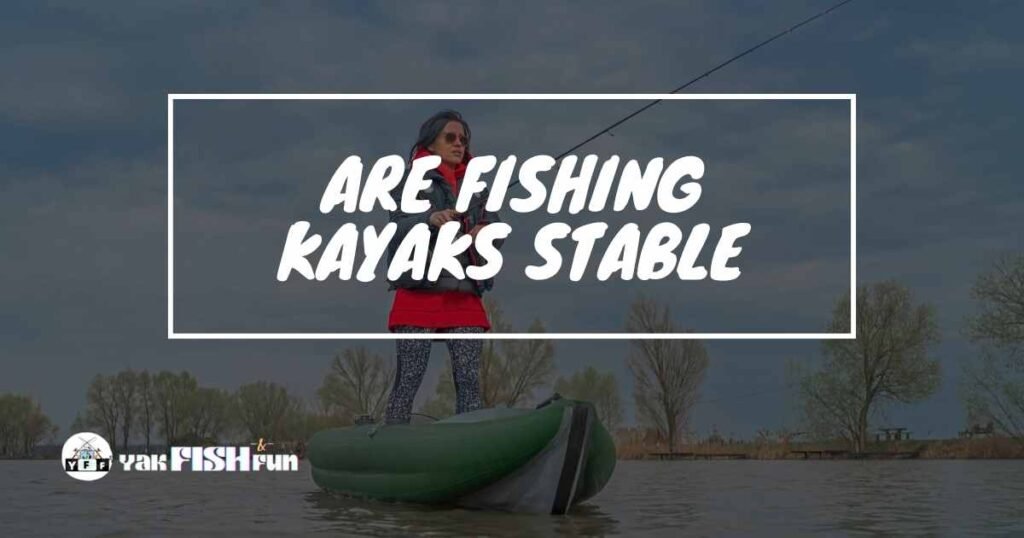Did you know that inflatable kayaks have become increasingly popular among anglers for fishing expeditions? But the question on many people’s minds is whether these inflatable kayaks are safe for fishing. Their lightweight and portable design offers convenience and ease of use, making them an attractive option for fishing enthusiasts. However, safety concerns linger in the minds of those considering this alternative to traditional kayaks.
Addressing these concerns head-on, we will explore the safety aspect of using inflatable kayaks for fishing. We will explore the potential risks and benefits of these innovative watercraft. Are there any specific dangers related to using fishing hooks while in an inflatable kayak? Can these vessels withstand rough waters or unexpected encounters with larger fish?
By examining the pros and cons, debunking myths, and sharing expert insights, we will help you make an informed decision about your next fishing adventure.
Table of Contents

How Do Inflatable Kayaks Ensure Safety While Fishing?
Safety is of utmost importance. These versatile watercraft have come a long way in terms of design and construction, incorporating various features to ensure a safe and enjoyable fishing experience. Let’s delve into the safety measures that make inflatable kayaks an excellent choice for anglers.
safety features Of inflatable kayaks for fishing purposes
Inflatable fishing kayaks are made with safety in mind to keep fishermen safe. They have a special safety feature called “multiple air chambers.” These are like separate pockets of air inside the kayak. They are different from regular hard kayaks.
These separate air compartments are important because they make the kayak more secure. If one part of the kayak gets a hole or puncture, the other parts filled with air will still keep the kayak floating. This way, you can safely go back to the shore without any worries.
stability and buoyancy of fishing in inflatable kayaks
Staying safe while fishing from an inflatable kayak depends a lot on how steady and afloat it stays in the water. Inflatable kayaks are specially designed to be really stable when the water is calm or moving gently. They do this by having a wider bottom and a flat shape that keeps them from tipping over or flipping.
These kayaks also stay afloat really well thanks to the strong materials they’re made from, like PVC or Hypalon fabric. These materials make the kayak last a long time and help it stay buoyant, even when you have lots of fishing gear with you. So, you can feel confident and safe while out on the water.
reinforced materials and construction techniques Of Inflatable Kayaks
Inflatable kayaks are made extra strong to handle the demands of fishing and to last a long time. They use tough materials and special building methods to boost their strength and safety. For example, important parts like the bottom, sides, and where you sit are reinforced with extra layers or patches to make them stronger.
What’s more, modern inflatable kayaks are put together using advanced techniques like heat welding or strong glues. This creates really solid connections between the materials, so the kayak is less likely to get holes or tears. With these tough materials and building methods, you can enjoy your fishing trips without worrying that the kayak might break.
safety measures: grab lines, D-rings, and self-bailing drain valves
Inflatable fishing kayaks have extra safety features that make your time on the water even better. Here are a couple of them:
- Grab lines: These are strong ropes placed on the sides of the kayak. If you accidentally fall into the water, you can hold onto these lines to help you get back into the kayak. They give you stability and something to grip onto.
- D-rings: These are sturdy rings shaped like the letter “D” that are attached to different parts of the kayak. You can use these rings to secure your fishing gear or add things like rod holders or fish finders. This way, your equipment stays safe and close by while you focus on paddling and fishing.
- Self-bailing drain valves: Some fishing inflatable kayaks have something called “self-bailing drain valves.” These valves are like little openings that let any water that gets inside the kayak flow out quickly. This keeps you dry and makes your ride safer by preventing the kayak from filling up with water.
With these additional safety measures in place, inflatable kayaks provide a reliable platform for anglers to enjoy their favorite pastime without compromising their well-being.
Comparing The Pros vs. Cons Of Fishing With An Inflatable Kayak
Choosing the right kayak is crucial. Anglers often debate whether inflatable kayaks are safe and suitable for their fishing adventures.
Advantages of Using an Inflatable Kayak for Fishing
- Portability: These kayaks are easy to carry around because they can be deflated and put into a small bag. So, whether you’re going on a short vacation or a remote fishing trip, taking your inflatable kayak along is simple and convenient.
- Ease of Storage: Unlike regular hardshell fishing kayaks, which need a lot of space, inflatable kayaks can fit in small closets or under your bed when you’re not using them. This is really handy if you have limited storage at home or live in a small apartment.
- Versatility: Inflatable kayaks can handle different types of water, like calm lakes, rivers, and even mild rapids. This means you can explore various fishing spots without worrying about where you can take your kayak.
- Affordability: Compared to their rigid counterparts, inflatable kayaks are more affordable without compromising quality or durability. They offer budget-conscious anglers an opportunity to enjoy fishing without breaking the bank.
Drawbacks of Using an Inflatable Kayak for Fishing
- Vulnerability to Punctures: Inflatable kayaks are tougher these days, but they can still get holes more easily than hard ones. Sharp hooks or rough things in the water can tear the kayak’s material, and this can make it lose air and become less stable.
- Weight Capacity Limitations: Inflatable kayaks can’t carry as much weight as hard ones. So, if you have a lot of heavy fishing gear or if you’re a bigger person, you should think about how much weight the kayak can handle before buying it. You don’t want to go over the weight limit.
Weighing the Pros and Cons
When comparing fishing kayaks, it’s essential to consider various factors such as cost, durability, and performance. Here’s a breakdown of how inflatable kayaks stack up against traditional fishing kayaks:
| Factors | Inflatable Kayaks | Hardshell Fishing Kayaks |
|---|---|---|
| Portability | Excellent | Moderate |
| Storage | Easy | Requires ample space |
| Versatility | Great | Limited |
| Affordability | Affordable | Expensive |
| Durability | Improved | Highly durable |
Tips for Making Your Kayak Fishing Safer With Inflatable Kayaks
Fishing from an inflatable kayak can be an enjoyable and accessible way to explore the water, but safety should always be a top priority. Here are some essential tips to ensure a safe and enjoyable kayak fishing experience with inflatable kayaks:
Tip 1: Choose the Right Inflatable Fishing Kayak
Inflatable options have gained popularity due to their portability and ease of storage. However, not all inflatable kayaks are created equal. To ensure a safer fishing experience, opt for a high-quality inflatable kayak specifically designed for fishing.
Look for features such as reinforced hulls made from durable materials like PVC or Hypalon, which offer better resistance against punctures. Consider models that have multiple air chambers so that even if one chamber gets damaged, the kayak remains buoyant.
Tip 2: Invest in Proper Fishing Gear
Equipping yourself with the right fishing gear is crucial for safety on the water. Make sure you have all the necessary equipment before heading out. A few essentials include:
- Life jacket: Always wear a properly fitted life jacket to ensure your safety in case of an accident.
- Paddle leash: Attach a paddle leash to your kayak and secure it around your wrist to prevent losing it in rough waters.
- First aid kit: Carry a compact first aid kit with essential supplies like bandages and antiseptic ointment.
- Whistle or signaling device: Have a whistle or other signaling device within reach to alert others in case of an emergency.
Tip 3: Be Mindful of Weather Conditions
Before embarking on your kayak fishing adventure, check weather forecasts and be aware of any potential changes throughout the day. Windy conditions can make paddling more challenging and increase the risk of capsizing. Consider postponing your trip or choosing a sheltered location if strong winds are predicted.
Moreover, always keep an eye on the sky for signs of approaching storms. Lightning poses a significant danger while out on open water. Head back to shore immediately if you notice dark clouds or hear thunder.
Tip 4: Utilize Fish Finders and Safety Gadgets
Fish finders not only enhance your fishing experience but can also contribute to safety on the water. These devices use sonar technology to detect underwater structures, helping you navigate safely and avoid hazards such as submerged rocks or shallow areas.
Consider investing in other safety gadgets like personal locator beacons (PLBs) or waterproof GPS devices. These tools can assist in alerting authorities of your location in case of an emergency.
Tip 5: Practice Proper Kayak Fishing Techniques
To ensure a safer fishing experience with inflatable kayaks, practicing proper kayak fishing techniques is essential. Here are a few key points to keep in mind:
- Balance: Maintain a stable center of gravity by distributing your weight evenly in the kayak.
- Casting: Avoid sudden jerky movements while casting to prevent losing balance and potentially capsizing.
- Anchoring: Use an anchor specifically designed for kayaks to secure yourself in one spot when needed.
- Navigation: Familiarize yourself with navigation rules and stay aware of other boats or kayakers around you.
Dealing with Potential Damage to Your Inflatable Kayak
Dealing with potential damage to your inflatable kayak is a crucial skill for any kayak enthusiast. Here’s a step-by-step guide on how to identify, repair, and prevent damage to your inflatable kayak:
Durability of Inflatable Kayaks
Inflatable kayaks have gotten better at staying strong and not breaking. They might not be as tough as the hard kayaks, but thanks to better technology, they are now much harder to damage.
These days, they make inflatable kayaks using strong materials like PVC or Hypalon. These materials are really good at not getting holes and can last a long time.
Puncture Prevention and Repair
Although inflatable kayaks are designed to withstand rough conditions, taking precautions to prevent punctures is essential. Here are some tips to keep your kayak safe:
- Inspect the Area: Before setting off on your fishing adventure, carefully examine the area where you plan to paddle. Remove any sharp objects that could potentially cause damage to your kayak.
- Avoid Rocky Surfaces: Try to steer clear of rocky surfaces or areas with sharp debris floating in the water. These can pose a higher risk of causing punctures.
- Protective Measures: You can make your kayak stronger by using extra things like keel guards or bottom skid plates. These help stop it from getting damaged
- Proper Inflation: When you blow up your kayak, make sure to follow the instructions from the company that made it. If you put in too much air, it can put too much pressure on the material, and that might make it easier to tear or get holes.
- Carry a Repair Kit: Always carry a repair kit for inflatable kayaks during fishing trips. This kit should include patches, adhesives, and other necessary tools for emergency repairs.
Suppose you do encounter a puncture while out on the water; don’t panic! Most inflatable kayaks come with repair kits that allow you to fix minor damages quickly:
- Locate the Leak: Inflate the kayak partially and listen for any hissing sounds or feel for escaping air around the damaged area.
- Clean and Dry: Clean and dry the damaged area thoroughly before attempting any repairs. This will ensure better adhesion of the patch.
- Apply Adhesive: Use the adhesive provided in your repair kit to apply a patch over the puncture. Follow the instructions carefully and allow sufficient time for the adhesive to bond.
- Reinforce if Necessary: For larger or more severe punctures, you may need to reinforce the patch with additional layers or use a larger patch size.
Regular Maintenance
To prolong the lifespan of your inflatable kayak and minimize potential damage, it’s crucial to practice regular maintenance:
- Rinse your kayak with fresh water after each use to remove saltwater, sand, or debris that could cause abrasion.
- Avoid prolonged exposure to direct sunlight when not in use, as UV rays can degrade the material over time.
- Store your kayak properly by deflating it completely and keeping it in a cool, dry place away from sharp objects.
Bottom Line
In conclusion, inflatable kayaks can be a safe and practical option for fishing enthusiasts. They are designed with safety features such as multiple air chambers to prevent sinking and durable materials to withstand potential punctures. Their stability and maneuverability make them suitable for various fishing conditions.


